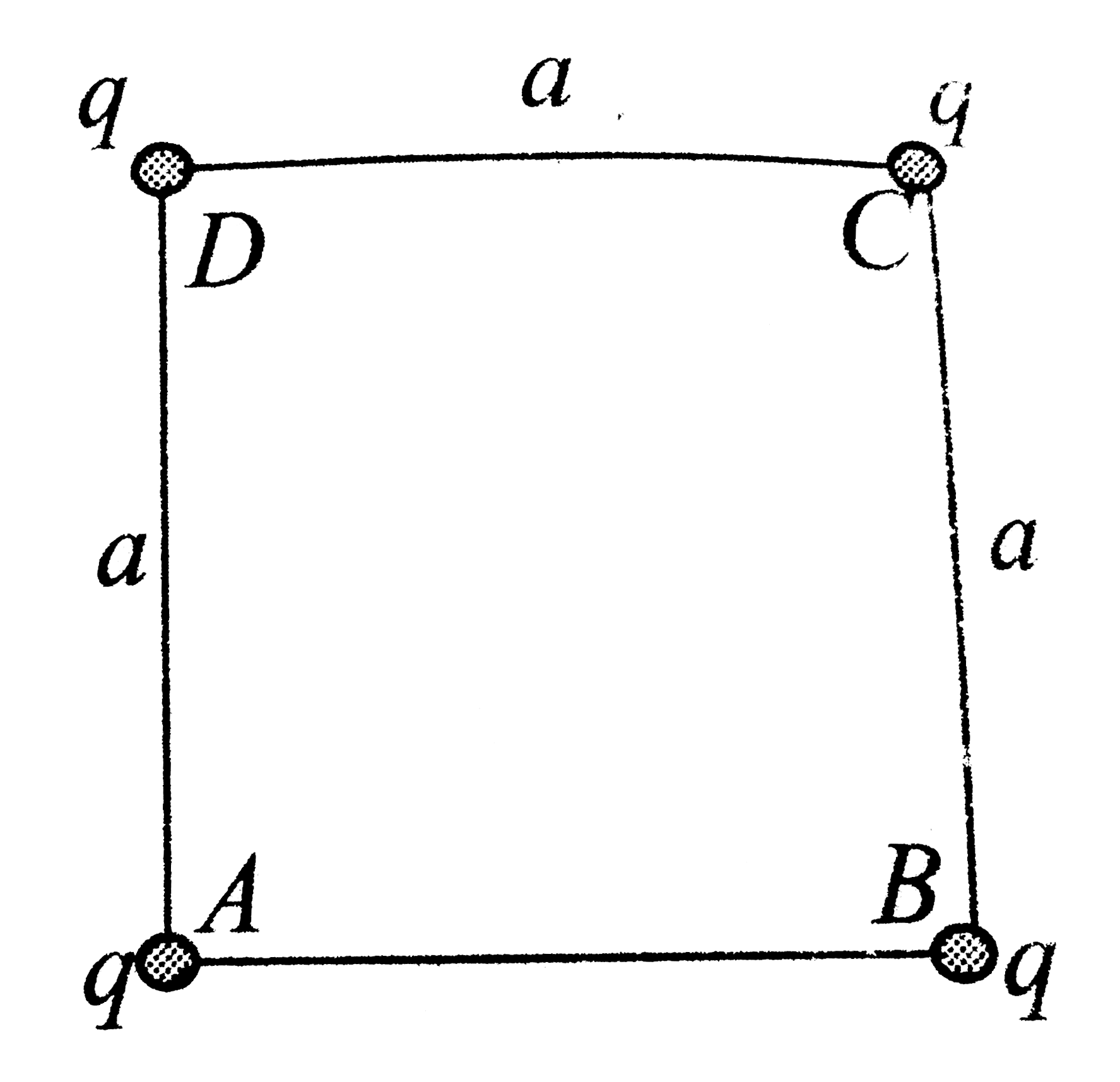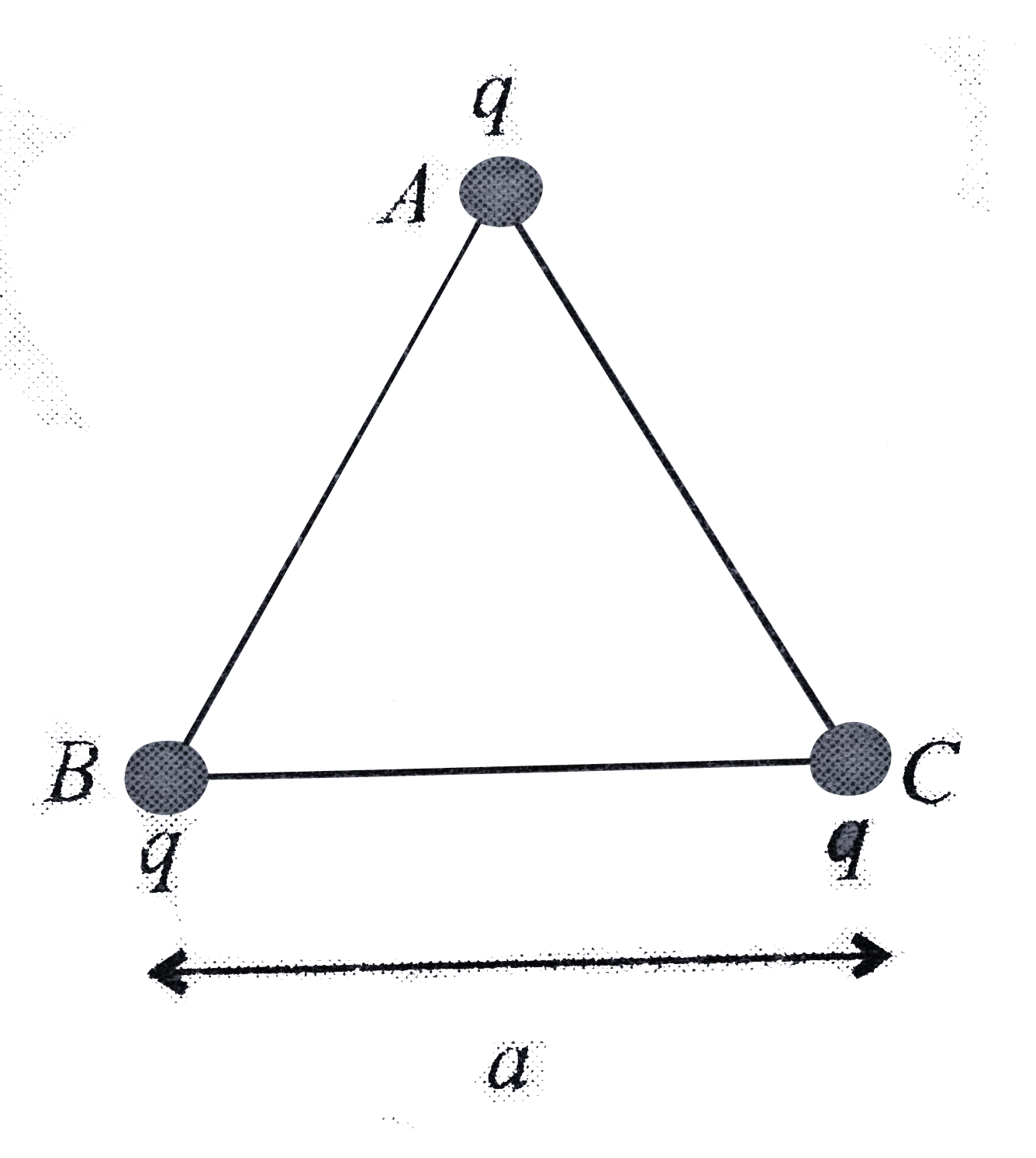Two identical charges are placed at the two corners of an equilateral triangle. The potential energy of the system is U. The work done in bringing an identical charge from infinity to the third vertex is
The correct Answer is:2
To solve the problem of calculating the work done in bringing an identical charge from infinity to the third vertex of an equilateral triangle where two identical charges are already placed at the other two vertices, we can follow these steps:
1. Understand the Configuration:
- We have an equilateral triangle with two identical charges Q placed at two corners (let's call them A and B).
- The side length of the triangle is A.
- We need to bring a third identical charge Q from infinity to the third corner (let's call it C).
2. Calculate Initial Potential Energy:
- The potential energy U of the system with the two charges Q at points A and B can be calculated using the formula for potential energy between two point charges:
U=kQ2A
- Here, k is Coulomb's constant.
3. Calculate Final Potential Energy:
- When we bring the third charge Q to point C, we need to consider the potential energy of the new configuration.
- The final potential energy Uf will include the interactions between all three charges:
- The potential energy between charge at A and charge at C:
UAC=kQ2A
- The potential energy between charge at B and charge at C:
UBC=kQ2A
- The potential energy between charges at A and B (which we already calculated):
UAB=kQ2A
- Therefore, the total final potential energy Uf is:
Uf=UAB+UAC+UBC=kQ2A+kQ2A+kQ2A=3kQ2A
4. Calculate Work Done:
- The work done W in bringing the charge from infinity to point C is equal to the change in potential energy:
W=Uf−U
- Substituting the values we have:
W=3kQ2A−kQ2A=2kQ2A
- Since U=kQ2A, we can express the work done in terms of U:
W=2U
Final Answer:
The work done in bringing the identical charge from infinity to the third vertex is 2U.
- We have an equilateral triangle with two identical charges Q placed at two corners (let's call them A and B).
- The side length of the triangle is A.
- We need to bring a third identical charge Q from infinity to the third corner (let's call it C).
- The potential energy U of the system with the two charges Q at points A and B can be calculated using the formula for potential energy between two point charges:
U=kQ2A
- Here, k is Coulomb's constant.
- When we bring the third charge Q to point C, we need to consider the potential energy of the new configuration.
- The final potential energy Uf will include the interactions between all three charges:
- The potential energy between charge at A and charge at C:
UAC=kQ2A
- The potential energy between charge at B and charge at C:
UBC=kQ2A
- The potential energy between charges at A and B (which we already calculated):
UAB=kQ2A
- Therefore, the total final potential energy Uf is:
Uf=UAB+UAC+UBC=kQ2A+kQ2A+kQ2A=3kQ2A
- The work done W in bringing the charge from infinity to point C is equal to the change in potential energy:
W=Uf−U
- Substituting the values we have:
W=3kQ2A−kQ2A=2kQ2A
- Since U=kQ2A, we can express the work done in terms of U:
W=2U
The work done in bringing the identical charge from infinity to the third vertex is 2U.
Topper's Solved these Questions
Similar Questions
Four identical point charges q are placed at four corners of a square of side a. Find the potential energy of the charge system.
 .View Solution
.View SolutionFour identical charges q are placed at the corners of a square of side a. Find the potential energy of one of the charges due to the remaining charges.
 .View Solution
.View Solution
Knowledge Check
- Question 1 - Select One
In the question number 4, work done in bringing a charge of 4×10−9 C form infinity to that point is
A2.4×10−4JB1.8×10−4JC3.2×10−5JD4.1×10−5J - Question 2 - Select One
Electric charges q,q,–2q are placed at the corners of an equilateral triangle ABC of side l. The magnitude of electric dipole moment of the system is
AqlB√3qlCzeroD4ql
Two equal charges q are placed at a distance of 2a and a third charge −2q is placed at the midpoint. The potential energy of the system is
View SolutionThree identical charges are placed at the vertices of an equilateral triangle. The force experienced by each charge, (if k=14πε0) is
View SolutionSix equal point charges q each are placed at six corners of a hexago of side a. Find out potential energy of charge system
 View Solution
View SolutionIf 3 charges are placed at the vertices of equilateral triangle of charge 'q' each. What is the net potential energy, if the side of equilateral Δ is lcm ?
View SolutionElectric charges q,q,–2q are placed at the corners of an equilateral triangle ABC of side l. The magnitude of electric dipole moment of the system is
View SolutionThree equal charges q are placed at the corners of an equilateral triangle of side A.
(i) Find out potential energy of charge system.
(ii) Calculate work required to decrease the side of triangle to a/2.
(iii) If the charges are released from the shown position and each of them has same mass m, then find the speed of each particle when they lie on triangle of side 2a.
 .View Solution
.View Solution

